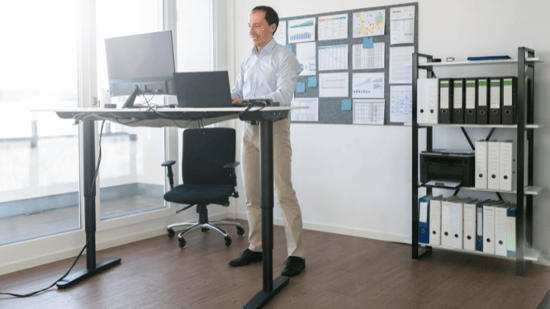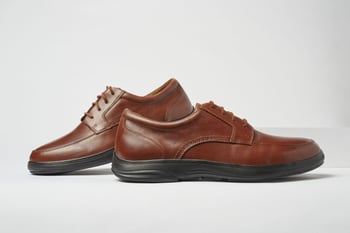Standing desks are a game-changer for many, offering a healthier and more productive work style. But for some, back pain can become a surprising side effect.
Here's the truth: standing desks are fantastic tools, but they require a shift in how we approach our workday. Don't let back pain steal your standing desk joy. To have a pain-free workday, focus on three things: good posture, ergonomic adjustments, and wearing supportive shoes.
This guide dives deep into the world of footwear for standing desk warriors. We will discuss comfortable shoes for various needs. We will also provide tips to keep your feet, legs, and back happy while working.

Why Shoes Matter for Standing Desks
Standing for extended periods puts a different kind of strain on your body compared to sitting. The constant pressure on your feet and ankles can radiate upwards, causing discomfort and pain in your legs, knees, and even your lower back.
Supportive shoes act as a buffer between your feet and the floor, absorbing shock and distributing your weight evenly. This not only reduces pain but also helps maintain proper posture, which is key to preventing backaches.
Features of Supportive Shoes for Standing Desks
Here are the key features to look for in shoes for standing all day:
- Cushioning: Generous cushioning in the soles is a must. Gel, memory foam, and EVA midsoles are all excellent at absorbing shock and providing comfort underfoot.
- Arch Support: Good arch support is crucial. Proper arch support distributes your weight evenly, preventing strain on your feet, ankles, and knees. Choose shoes that match your arch type (flat, neutral, or high).
- Stability: A stable shoe with a wider base will help you maintain proper posture and reduce fatigue. Look for shoes that don't wobble or roll excessively when you walk.
- Shock Absorption: Step lightly on your joints. Features like air pockets and special heel cushioning significantly reduce the impact you feel with each step.
- Breathability: Standing for hours can lead to sweaty feet. Opt for shoes made from breathable materials like mesh or knit fabrics to keep your feet cool and dry.
- Removable Insoles: If you have custom orthotics, choose shoes with removable insoles to ensure a comfortable, customized fit.
Choosing the Right Shoe for Your Needs
Not all standing desk warriors are created equal. The type of shoe you choose may depend on your activity level, work environment, and personal preferences. Here's a breakdown of some popular options:
- Athletic Shoes: A versatile choice offering good cushioning, arch support, and stability. Opt for walking shoes or cross-trainers that provide a good balance of comfort and support.
- Walking Shoes: Designed for long-distance comfort, walking shoes typically have excellent cushioning and shock absorption. Look for features like breathable mesh uppers and supportive midsoles.
- Clogs and Sandals (with Arch Support): These can be comfortable options for some, especially in warmer office environments. However, ensure they have good arch support and a stable sole to avoid excessive ankle strain.
- Dress Shoes (with Comfort Features): Work attire doesn't have to mean sore feet. Prioritize comfort features like well-cushioned soles and supportive insoles in your dress shoes.
Beyond Shoes: Tips for Back Pain Prevention
The right shoes are a great first step, but here are some additional tips to keep back pain at bay while using a standing desk:
- Practice Good Posture: Stand tall with your shoulders back and relaxed, core engaged, and weight evenly distributed on both feet.
- Adjust Your Workstation: Place your monitor at eye level and position your keyboard and mouse for comfortable arm and wrist posture.
- Take Breaks: Don't stand for hours on end. Take frequent short breaks to move around, stretch, and sit down for a few minutes. Aim for a 2:1 ratio of standing to sitting throughout the day.
- Strengthen Your Core: A strong core helps maintain proper posture and reduces strain on your back.
- Stretch Regularly: Stretching your calves, hamstrings, and lower back throughout the day can improve flexibility and prevent tightness that can contribute to back pain.
Conclusion: Standing Tall with Comfort
Combatting back pain at a standing desk goes beyond just good posture. While maintaining proper form and making ergonomic adjustments are crucial, your footwear plays a surprisingly significant role.
Look online for "shoes for back pain." These shoes can evenly distribute your weight, cushion impact, and support your arches. With the right approach, a standing desk can be a powerful tool for staying healthy, productive, and naturally comfortable throughout your workday.



.png?width=116&name=Anodyne_circle_1_logo%20(2).png)
